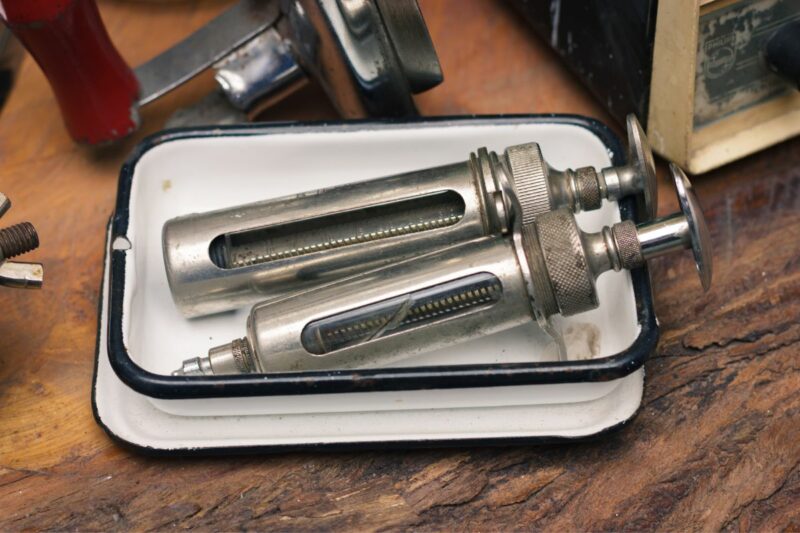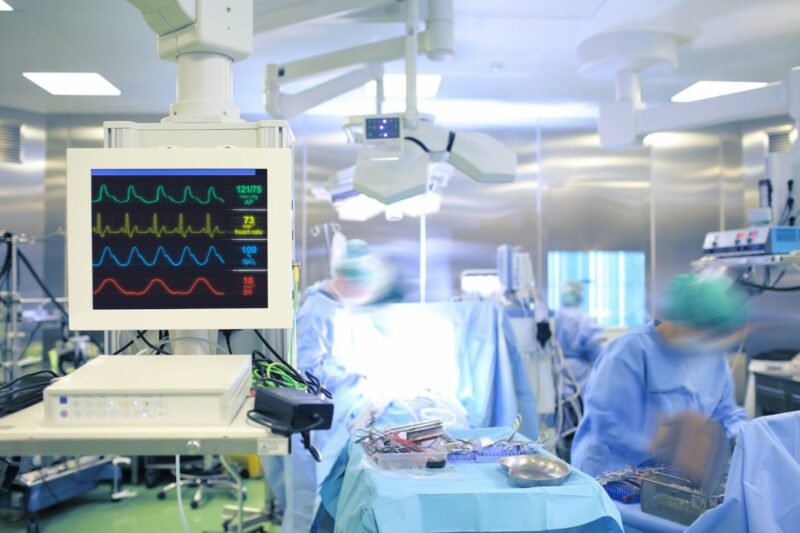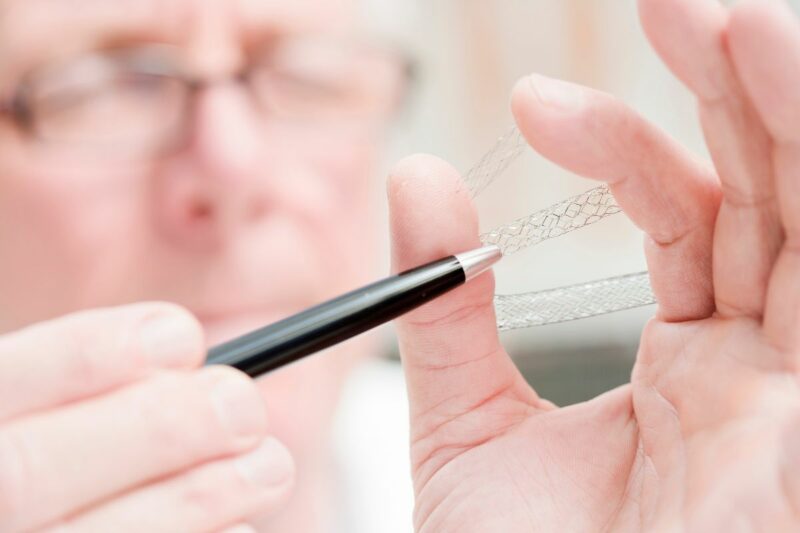
Antique brass syringe.
Medical devices, even in their crudest forms, have been around for many centuries. In the beginning, metals were the primary materials used for medical devices, including surgical instruments, dental implants, and catheters. At the turn of the 20th century, the development of more complex devices promoted materials innovations.
In the 1930s, these innovations led to strong and heat-resistant ceramics introduced as dental and bone implants as well as glass used for bone replacement, storage, vials, and tubing. By the middle of the 20th century, developments in plastic materials began to radically transform the health care industry.
Today and in the future, plastics will continue to take a leading role in medical device development.

Surgical room in a hospital.
Sterility
One of the relentless challenges in the health care industry, historically and still today, has been to keep bacteria, viruses, and the diseases they cause from spreading. Prior to the middle of the 20th century, medical devices, made of glass, ceramics, or metals, were intended for multiple uses. Even though these devices were sterilized between uses, they regularly caused cross-contamination between patients along with a high patient mortality rate. The introduction of economical, mass-produced plastic-based devices led to the shift towards single-use devices at a larger scale in the 1960s. Such products helped to prevent the spread of dangerous diseases by eliminating reuse and the need to sterilize a device. Plastics can also lend themselves to incineration for safer disposal than their metal or ceramic alternatives.
Even with the benefits of single-use, plastic devices, healthcare-acquired infections continue to pose a huge risk. In the U.S. alone, there are approximately 1.7 million healthcare-acquired infections per year, resulting in increased healthcare costs and even death for 99,000 cases. Antimicrobials, such as silver ions, copper salts, and zinc compounds, can be incorporated into plastic materials to create surfaces that can inhibit the growth of microorganisms, further reducing the spread of dangerous diseases. The existing generation of antimicrobial plastics can reduce bacteria by up to 99.99%, and are used in everything from catheters to hospital room doorknobs.
Outside of hospitals, experimental environments can also benefit from the use of single-use and antimicrobials plastics. These plastics can help to speed-up the research and development of new vaccines by removing the need to repeat a study that has been compromised by cross-contamination.
Safety
The use of ceramics and glass in the healthcare industry poses additional risks due to their brittle nature. These materials fracture easily, which result in surfaces with dangerous, sharp edges. Plastics on the other hand are tougher and more durable, which allow for their use in medical packaging, blister packs, and various medical waste disposal bags. Plastics are also lighter and make a more convenient storage and transportation options.
Increased Comfort
One of the most popular surgeries in the U.S. and Europe is hip replacement surgery. For many years, metal-on-metal replacement hip sockets were used. Today, hip socket designs are made with carbon fiber-reinforced polyetheretherketone (PEEK) plastic. These designs demonstrate superior biocompatibility than their metal counterparts. They also more closely replicate the performance of a natural human hip.
Plastics can be molded into highly customized shapes that are lightweight and durable. These characteristics not only provide a more comfortable prosthetic for amputees, but also provide specialized solutions that allow for healthier and normal lives. Take for instance plastic implants for people with severely impaired hearing. These small devices consist of numerous components that can bypass damaged cells to directly stimulate the auditory nerve, allowing patients to hear again.

Implantable stents.
Innovative Applications
The unique behavior of plastic allows for the development of fascinating medical devices that were previously unimaginable. Take for instance resorbable implants. Stents can be made from corn-based plastic to improve blood flow in clogged arteries. Traditional stents made from metal can cause additional cardiac issues in some patients. Plastic stents, on the other hand, are safely absorbed by the body after its job is complete.
While heart disease threatens the lives of millions, the number of hearts available for transplant are limited. A total artificial heart can be made of plastic and replace both ventricles and the four heart valves. This medical device, powered by a portable, external pneumatic pump, can extend the lives of heart failure patients while they are awaiting a transplant.
Speed to Market
With the COVID-19 outbreak occurring globally, the healthcare industry is facing another crisis by way of equipment and supply shortages. However, the ease and speed at which plastic components can be fabricated today, offers solutions outside of traditional manufacturing channels.
In Italy, 3D-printing start-up company, Isinnova, is producing plastic Venturi valves that connect respirators to oxygen masks for a local hospital when the original equipment manufacturer (OEM) was unable to keep up with demand. Other companies are looking to utilize 3D printing for much more complicated ventilation devices that are also experiencing a higher demand. Across the world, companies are working to close the gap on personal protective equipment for healthcare workers by 3D printing supplies including face shields.
No other materials have played such a key role in transforming the healthcare industry as plastics. Plastics have been able to successfully evolve along with the industry’s ever-changing needs. These materials will continue to enable innovations in the healthcare industry that we can only dream about today, as well as help to improve the quality of life for those it serves.
